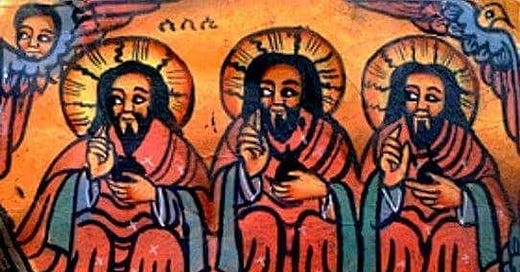The Bible Teaches God is Triune 100 Times Over
Scripture Teaches God's Nature is Triune. Mainly, by its UNDENIABLE Trinitarian Theological Pattern. Receipts Follow...
The Bible emphatically teaches us that the nature of God is Triune. One key way is by what scholars call the “Trinitarian Theological Pattern”. In this article, I elaborate on three New Testament examples of this unmistakeable “Trinitarian theological pattern”.
THE PATTERN DEFINED
The Old Testament definitely teaches there is only one God (Deuteronomy 6:4). Of course, the New Testament teaches monotheism as well (1 Corinthians 8:6). Specifically, the NT teaches monotheistic trinitarianism: that the one true God exists eternally as three distinct, yet co-equal persons. Namely, God the Father, God the Son, and God the Spirit. The one true God exists eternally as three distinct persons. This – tri-unity – is the picture painted regarding the nature of the God of the Bible.
One method by which Scripture teaches the Triune nature of God is by what many theologians describe as a “Trinitarian theological pattern”. Veteran Christian apologist Robert Bowman explains:
“By a Trinitarian theological pattern is meant something more than just any triadic pattern in Scripture, and on the other hand, something less than a formal, systematic exposition of the doctrine of the Trinity using technical theological terms such as Trinity, persons, substance, coinherence, and the like.”
This pattern is not merely anytime we see a threefold pattern; it’s more than that. This pattern also does not read like a textbook. Yet this pattern is woven all throughout Scripture, in an organically intertwined fashion. A great example is Luke 10:21-22 (pay close attention to the bolded words):
In that same hour he rejoiced in the Holy Spirit and said, “I thank you, Father, Lord of heaven and earth, that you have hidden these things from the wise and understanding and revealed them to little children; yes, Father, for such was your gracious will. All things have been handed over to me by my Father, and no one knows who the Son is except the Father, or who the Father is except the Son and anyone to whom the Son chooses to reveal him.
What did you see? Jesus is full of the Holy Spirit. Jesus praises the Father (in the Holy Spirit). Jesus affirms that no one knows who the Father is except for the Son and no one knows who the Son is except for the Father. Jesus said all of this in the Holy Spirit. This is a perfect example of the Trinitarian theological pattern. And even though it’s just “sitting there”, plain as day, in the Gospel of Luke, you may miss it if you aren’t vigilantly observing the text. My intent is for this article to aid you in your exegetical vigilance! Bowman continues his explanation of the pattern:
As used here, a Trinitarian theological pattern is one in which the biblical writings speak of the Three in such a way as to reveal in some way, explicitly or implicitly, their coordinate divine status. The texts may refer to the Three as Father, Son, and Holy Spirit, or as God, Christ, and Spirit, or in some variation on these designations, but it should be reasonably clear in each text that the Three are in view.
The nuance here may feel a tad “dense” to the reader. Yet, I bet that most Bible students can readily call to mind numerous times they have seen this pattern, in some way, displayed in the Bible. For example, in John 15:26, Jesus tells the disciples he will send the Helper/Spirit of truth, who is from the Father, and then the Spirit will testify about Jesus! Similar examples of a trinitarian theological pattern abound all throughout the Gospel of John: John 3:34-35, 4:23, 6:61-65, 14:16, 26, 16:7-15, 20:21-22.
Bowman adds, “from a ‘narrative’ hermeneutical perspective, a Trinitarian theological pattern is one in which the Father, Son, and the Holy Spirit play identifiable, coherent roles in the narrative or account of God’s activity in the world”.[1]
A good example of the pattern embedded into the narrative is in Matthew 3:16-17. The narrative tells of the Holy Spirit descending, the Father speaking, and the Son rising out of the water (also see Mark 1:8-12 and Luke 3:21-22). The simultaneous (and yet distinct) reality of all three persons is on full display during the baptism of Jesus.
THE PATTERN DEFENDED IN CONTEXT
Let’s go back a little and put these texts in a larger context. The core of the earliest preaching (kerygma) of the church is simply that “Jesus is Lord” (Romans 12:9; 1 Corinthians 12:3; Philippians 2:11). This proclamation is bolstered by a call to action: hearers should believe in God and in his Son (Acts 17:30-31; 1 Thessalonians 1:9-10).
Many passages reflect this, referencing Father and Son together. Examples of this “binitarian” kind are Matthew 11:27; John 5:17-26, 17:3; 1 Corinthians 1:3; 8:6; James 1:1; 2 John 3. Yet, other passages couple Father and Spirit (Luke 11:13; 1 Thessalonians 4:8) or Son and Spirit together (Matthew 12:31-32; Acts 9:31; Galatians 3:13-14; 1 Peter 1:11-13).
The members of the Trinity are mentioned, in some manner, repeatedly, in every single book of the New Testament. The “Spirit” alone is mentioned 250 times in the New Testament. In an average Bible, the reader will see the “Spirit” mentioned about once per page. The “Father” and the “Son” are BOTH referenced, in some manner, about twice per page in an average Bible. Indeed, by every measure, the New Testament clearly exhibits a “Trinitarian theological pattern”.
When properly exegeted in context, these “Trinitarian theological pattern” passages show the New Testament writers understood the Father, Son, and Spirit as fully divine persons. In fact, there are between 85 and 117 triadic passages in the New Testament (the number varies on where one draws the cut-off regarding length).[2] It can truly be said that the whole New Testament is triadic in pattern.
In this post, I have already exposed you to quite a few illustrations of this pattern. Now, I will cover more three examples of the Trinitarian theological pattern: 2 Corinthians 13:14, 1 Corinthians 12:4-6, and Matthew 28:19. These three will receive a little more attention.
EXAMPLE #1: 2 CORINTHIANS 13:14
OUR PRAYERS ARE TRINITARIAN
“The grace [charis] of the Lord Jesus Christ and the love of God and the fellowship of the Holy Spirit be with you all” (2 Corinthians 13:14).
This letter to the church at Corinth concludes with the above benediction – and it is fully trinitarian. Look at the grammar: “grace of the Lord”, “the love of God”, and “fellowship of the Holy Spirit”.
The personal aspects of all three Persons of the Trinity differentiate them from one another. The Father is God and yet not the Son or the Spirit. The Son is God and yet not the Father or the Spirit. The Spirit is God and yet not the Father or the Son.
Paul equates “the activity of the three divine Persons … in concert”, writes the late New Testament scholar Gordon Fee. Additionally,
This suggests that Paul was fully trintarian in any meaningful sense of that term–that the one God is Father, Son, and Spirit, and that when dealing with Christ and the Spirit one is dealing with God every bit as much as when one is dealing with the Father. Thus, the benediction, while making a fundamental distinction among God, Christ, and Spirit, also expresses in shorthand form what is found throughout his letters, namely, that ‘salvation in Christ’ is the cooperative work of God, Christ, and the Spirit. [3]
Here, we are reminded that our salvation itself is a fully Trinitarian work. We are also steeled against form of Modalism and its related arguments. Love is a definitive characteristic of personhood, as is fellowship [koinonia]. This fact is contra any form of Oneness Theology, which speaks of natures or modes instead of persons.
The ’of’ in the clause “the love of God” is a subjective genitive. This means “the love of God” should be understood by the reader as “the love which comes from God”. Paul is praying that the love of God would be with the Christians at Corinth. A pastoral note here: God loves us and we are to love him in response. That is the objective genitive here, that we, like the Corinthians, should have love for God.[4]
Taken all together, the meaning of these verses is incredibly significant. As gifted New Testament scholar Craig S. Keener notes, “Most Jewish writers treated the Holy Spirit as an aspect of or force from God; Paul links the Holy Spirit here as a divine person alongside Jesus and the Father”.[5]
Paul’s final customary prayer here in 2 Corinthians 13:14 is one of the strongest New Testament examples of the Trinitarian theological pattern. It is indisputable evidence for the truth of the Holy Trinity.
EXAMPLE #2: 1 CORINTHIANS 12:4-6
OUR GIFTS ARE TRINITARIAN
“Now there are varieties of gifts, but the same Spirit; and there are varieties of service, but the same Lord; and there are varieties of activities, but it is the same God who empowers them all in everyone” (1 Corinthians 12:4-6).
This passage helps us appreciate the diversity of gifts in the church. Fundamental to the argument here, is that these different gifts are still from the same source! Brian Edgar comments: “God is not divided, the whole character of God flows through all the gifts, and every individual gift is a specific manifestation of God who is at work in the lives and ministries of his people”.[6]
We should appreciate that there are different kinds of gifts given to serve. But we should also appreciate these gifts are from the same Triune God. As Fee observes:
Paul here refers to the post-redemptive work of God in Christians, equipping them for service to the Body of Christ, and in both passages the Father, Son, and Spirit are presented on a level parallel to each other.[7]
Here we see the same (Holy) Spirit giving different gifts to different church members. We also see the same Lord (Jesus) equipping believers to enact different forms of service. Lastly, we see the same God (the Father) empowering these different works. How could we honestly describe 1 Corinthians 12:4-6 as anything other than a Trinitarian theological pattern?
EXAMPLE #3: MATTHEW 28:19
OUR MISSION AND OUR BAPTISM IS TRINITARIAN
“Go therefore and make disciples of all nations, baptizing them in the name of the Father and of the Son and of the Holy Spirit” (Matthew 28:19).
The context of Matthew 28:19 is this: Jesus has full, universal authority. This level of authority clearly surpasses any mere human figure. Indeed, Jesus is greater than David. His authority surpasses David and the rest of his royal, human line. Jesus then commands his disciples to go out to all nations.
As we see by the baptismal formula he gives, the mission itself is ultimately Trinitarian. Otherwise, it wouldn’t make sense for the baptizing of future disciples to be done in the name of the Father, Son, and Spirit. Jesus promises to be with his disciples to the end of the age, as they go about obediently fulfilling this “Great Commission”.
On a related note, Matthew 28:19 also displays “a grammatical differentiation between two or all three Persons of the Trinity”, Dr. Edward Dalcour writes. Indeed, for “the Greek conjunction kai is inserted between nouns of the same case and each of those nouns is preceded by the article ho”.[8]
This is grammatically important because of a rule that scholars of biblical Greek know: Sharp’s Rule. The grammarian Sharp observed “that when three articular nouns of the same case are connected by the copulative kai”[9], then each noun denotes “a different person, thing, or quality from the preceding noun”.[10] To emphasize this, I follow Dalcour in emphasizing the literal rendering of Matthew 28:19:
“baptizing them in the name of
the [tou] Father
and [kai] the [tou] Son
and [kai] the [tou] Holy Spirit”.
Through all of this, we notice: Jesus includes himself in between the Father and the Spirit. Second Temple Judaism considered the Holy Spirit to be the Spirit of God, and therefore divine (although the Spirit was not yet understood as personal, as he is here and in the NT corpus). For Jesus to list himself in between the Father and the Spirit here is without a doubt a claim to deity. Matthew 28:19 is yet another robust example of the New Testament’s Trinitarian theological pattern. (My upcoming Trinity debate).
OUR BOOK IS TRINITARIAN!
B.B. Warfield, the influential Reformed theologian, correctly wrote that “The whole book is Trinitarian to the core; all its teaching is built on the assumption of the Trinity; and its allusions to the Trinity are frequent, cursory, easy and confident”.[11]
Why have Christians throughout the centuries held fast to the sublime and challenging claim that the God of the Bible is Triune? Because the Bible, and especially the New Testament, teaches that our God is Tri-personal. The most prominent way the Triune nature of God is displayed in Scripture is the Bible’s bold and repeated Trinitarian theological pattern.
NOTES
[1] Robert M. Bowman Jr, The Journal for Trinitarian Studies and Apologetics (Vol. 1, No. 1, January 2013), 9.
[2] Bowman provides a chart in his “Triadic New Testament Passages and the Doctrine of the Trinity”, 15-26.
[3] Gordon D. Fee, Paul, the Spirit, and the People of God (Peabody, MA: Hendrickson, 1996), 41.
[4] I am indebted to Brian Edgar’s discussion of the passage here. Brian Edgar, The Message of the Trinity: Life in God (Downers Grove, IL: IVP, 2004), 46-47.
[5] Craig S. Keener, NIV Cultural Backgrounds Study Bible (Grand Rapids, MI: Zondervan, 2016), 2041.
[6] Brian Edgar, The Message of the Trinity: Life in God (Downers Grove, IL: IVP, 2004), 253
[7] Gordon D. Fee, Paul, the Spirit, and the People of God (Peabody, MA: Hendrickson, 1996), 41.
[8] Edward L. Dalcour, A Definitive Look at Oneness Theology: In Light of Biblical Trinitarianism, 4th Ed. (Potchefstroom, South Africa: North-West University, 2016), 194.
[9] Michael R. Burgos, Jr., Against Oneness Pentecostalism: An Exegetical-Theological Critique, 2nd Ed. (Winchester, CT: Church Militant Publications, 2017), 108.
[10] Granville Sharp, Remarks on the Uses of the Definite Article in the Greek Text of the New Testament; Containing Many New Proofs of the Divinity of Christ from Passages which are Wrongly Translated in the Common English Version, 3rd Ed. (London: Vernor and Hood, 1803), 14.
[11] B.B. Warfield, “The Biblical Doctrine of the Trinity,” The Works of Benjamin B. Warfield (Grand Rapids, MI: Baker, 1981), II:143.








